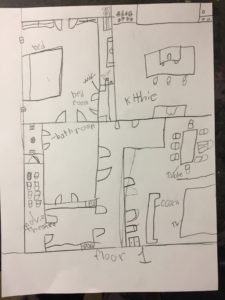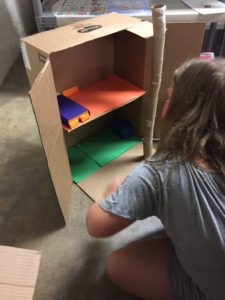Designing Dream Houses and considering the environment

Starting the floors
This week I taught the concept of dream houses, where students can make floor plans of their buildings and construct at least one floor in 3-D. We only had one student this week, so she got extra attention from both of us. After starting with the opening ceremony, asking what she did that was creative this week, I explained that she would be making a dream house that could be for humans, animals or other beings. I wanted her to consider the environment and context for her house. Would it be communal or solitary? Who would live there and how would you consider the area around the house as affecting the design and function of the place? Then I showed my examples and emphasized how people would move from one room to another as well as energy uses in the house. After, I showed some slides about Erwin Wurm’s, Fat House in Vienna, the fanciful, automaton, Hellbrunn Castle in Germany, and communal experiment, Arcosanti in Arizona.

Starting the floor plan
Originally in the lesson, I wanted students to write a story or narrative about their design for the viewer in the later exhibition we would have at the end, but since there was only one student, I let her spend more time on her 3-D piece because her usual buddy was absent today, so there was some time spent in focusing her actions. She might be there next week when she can completely finish her project and do the writing and exhibiting. She spent a good amount of time on the sketch, which I was surprised by, because in the other classes they all seemed to want to jump into 3-D instead of the drawing part. She made a great drawing and added details like a movie room and a special bedroom for her mom. I explained how to add symbols for doors and windows that architects use including labeling the floor plans.
I’m trying to focus on enjoying the act of teaching more; since there is so much prep time, sometimes you can lose focus on the actual teaching. In Michael Linsin’s, Classroom Management for Art, Music and PE Teachers, he talks about developing a love for teaching that affects student motivation and the artwork produced. If you love your lessons and are excited about imparting them, the students will be better engaged and behaved. Part of this requires knowing the interests of your students and giving choices as motivational factors. Knowing what excites them can give your lessons a lot of life.

Recycled materials to use for 3-D work

Floor plan of one student
Overall, I think this lesson was successful because the student made a complete product of a floor plan in 2-D and 3-D, considering the location and inhabitants of the house. I used formative assessment as the main tool during this activity since there was only one student, asking her questions about the considerations for her piece. I think in the future, I would also emphasize scale more, especially with older students and add in a math component using rulers. One final part to consider is if students want to use entire boxes, like she did, these lessons might require another class period. If they were just building one floor, it would take less time. Had she finished her story in time, this would have been a nice example of Stephanie Juno’s chapter in Artful Teaching, that describes “making learning visible” through additional artifacts of the process and accompanying text to help explain what she learned in the activity.

Working on the final piece

Final piece